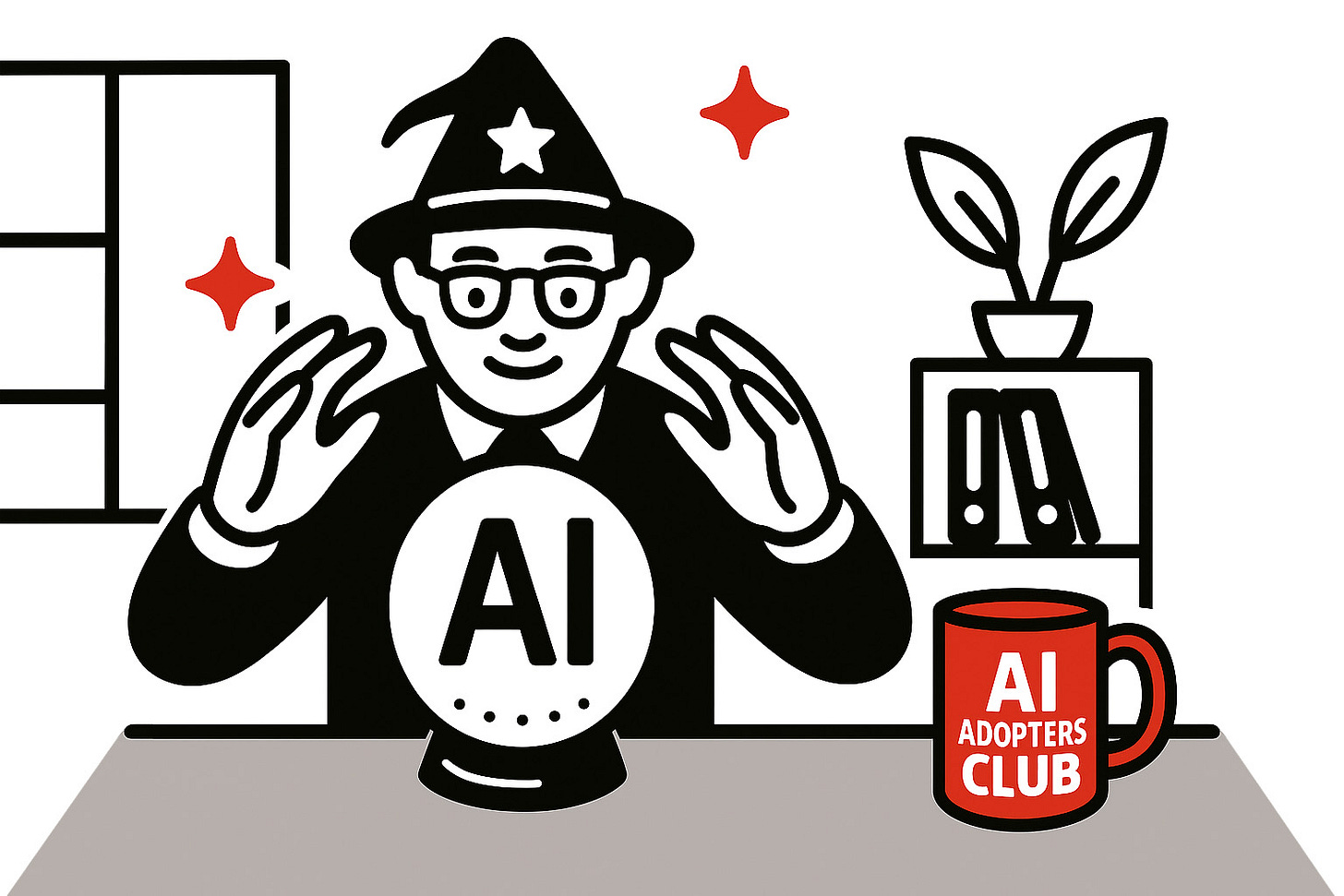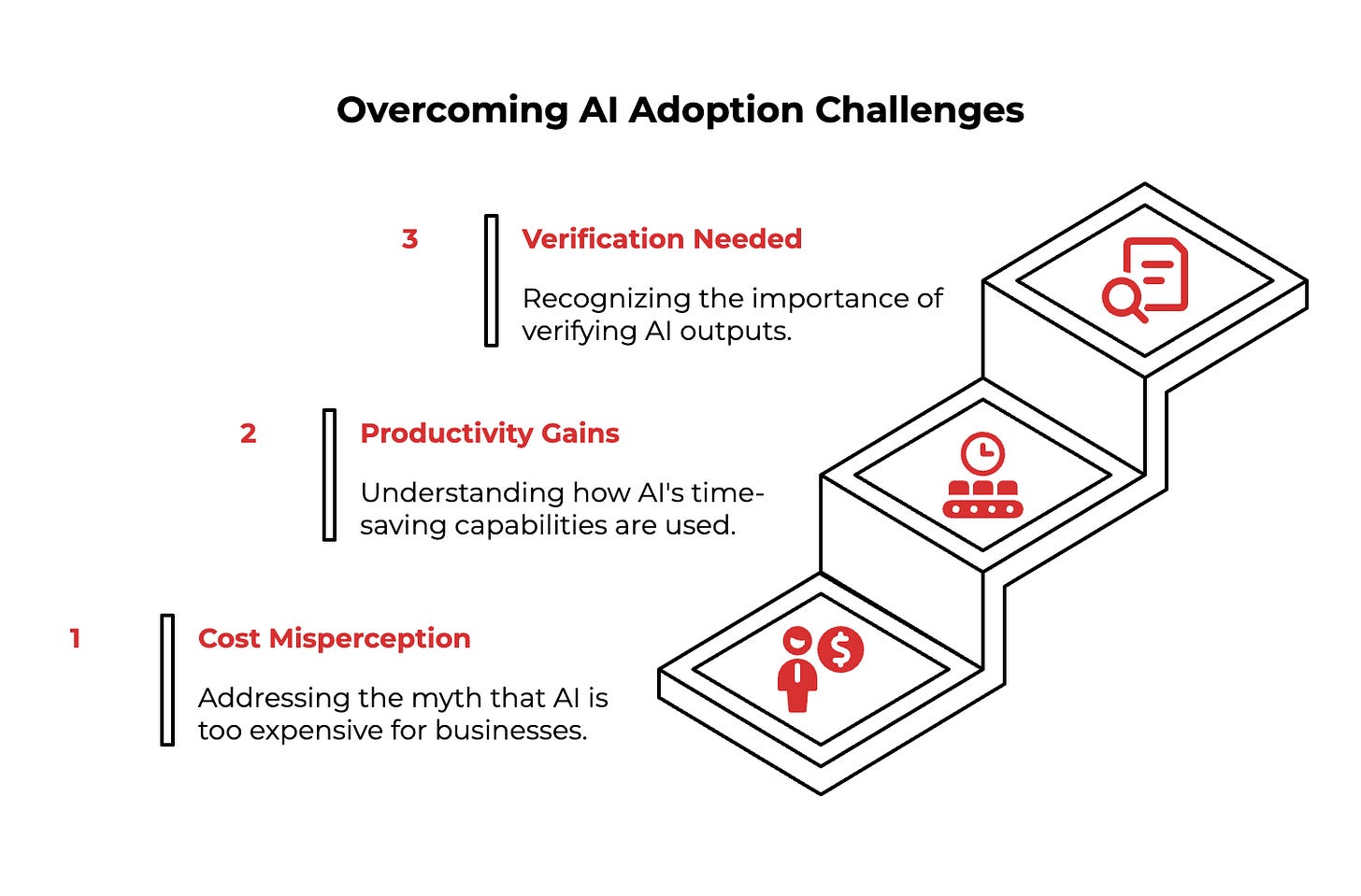10 AI Myths Killing Your Business Results
Stop wasting money on AI fantasies and start getting real workplace value
Hey Adopter,
Another week, another flurry of "AI breakthroughs" hitting your inbox, often pushed by folks who think "generative" means it’s very generous. The corporate atmosphere is saturated with AI talk, but peel back the jargon, and a lot of it feels like rearranging deckchairs on a ship that’s not even sure which port it’s sailing to.
It’s time for a reality check, a moment to slice through the corporate theatre and the echo chamber of buzzwords. We’re tackling some persistent AI myths, the kind that hamstring good intentions and keep businesses spinning their wheels. These aren’t new problems; they're often old workplace habits dressed up in new tech clothing.
Consider this a moment of shared reflection.
10 AI Truths Your Company Needs To Hear
No sugar-coating. Just direct insights to help you lead with clarity.
1. That Price Tag Panic
The Office Echo: You’ve heard it, the standard line in budget meetings where good ideas often get quietly shelved: "AI is purely for the titans with cash to burn. We’re just trying to keep the lights on." It’s a sentiment many small business founders share, though clarity on which AI costs what often dissolves into vague hand-waving. It’s a convenient deflection from deeper questions.
The Real Bottom Line: Let's cut through that. Building your own version of a Hollywood AI is pricey, no argument there. But the AI that actually moves the needle for most businesses? That’s a different beast entirely, often costing less than the executive team's weekly expense-account lunches. Think powerful subscription tools falling between $20 and $500 a month. Off-the-shelf options can start at zero, climbing to $25,000 annually, but typically only when they’re already delivering more value than they cost. The real hurdle usually isn't the price; it's the fuzzy thinking around what problem needs solving. It's time to stop using cost as a shield for indecision and start asking sharper questions about value.
2. The AI Overload Groan
The Office Echo: "It’s in everything now! My email, my project software, I’m half expecting my office chair to offer AI-driven postural analysis. It's gone from exciting to just… relentless." The sentiment is that AI is becoming an omnipresent, slightly annoying, digital assistant.
The Real Bottom Line: "AI washing" is certainly a popular corporate sport, where "AI-Powered" gets slapped on products as if it's a guarantee of advanced intelligence. But don't let the marketing fluff obscure the genuine utility. Real AI integrations, when done right, deliver substantial benefits, such as intelligent customer service bots that actually resolve issues or personalization that feels helpful, not creepy. The skill is in distinguishing genuine value from superficial claims. Focus on tools that solve a real problem, not just those that look good on a PowerPoint slide.
3. The Reputation Risk Ruse
The Office Echo: "If I start using AI for my core tasks, people will think I'm lazy, or that I don't actually know my job. Better to just keep my head down and do it the old way." There's a palpable fear among professionals about the social stigma of AI use.
The Real Bottom Line: This concern isn’t entirely unfounded; some studies do show a potential "social evaluation penalty". However, this often diminishes if managers themselves are AI adopters, or if the company culture actively endorses intelligent tool use. Increasingly, effective AI utilization is seen as a strategic skill, a sign of adaptability rather than a deficiency. The greater reputational risk? Being the one who resists tools that could deliver demonstrably better and faster results.
4. The Shorter Workday Mirage
The Office Echo: "With AI handling all the repetitive stuff, surely we'll all be working fewer hours and achieving that mythical work-life balance!" Yet, many find their workdays are expanding, not shrinking.
The Real Bottom Line: It's a seductive vision, but AI’s time-saving capabilities rarely translate directly into more free time. That reclaimed efficiency usually gets poured straight back into more work, higher output expectations, or tackling new, more complex projects that AI just brought within reach – classic scope creep. The productivity paradox is alive and well. Unless you proactively ring-fence those saved hours for higher-value strategic work, the organization will find a way to fill them.
5. The "AI Is a Brain Double" Delusion
The Office Echo: "Why use AI? You should think for yourself!" This is the common refrain when AI assistance is suggested for tasks requiring thought, treating AI like a forbidden shortcut.
The Real Bottom Line: AI isn’t a replacement for human cognition; it’s a force multiplier. Current AI lacks true understanding, common-sense reasoning, and the nuanced judgment that comes from human experience. It excels at processing data, identifying patterns, and generating drafts. Your role shifts to asking smarter questions, critically evaluating the outputs, and applying strategic oversight. Think of AI as the brilliant, tireless analyst; you're still the strategist calling the shots.
6. The Flawless Output Fantasy
The Office Echo: "AI-generated content? It's so advanced now, it must be accurate and ready to use straight out of the box." This is often coupled with surprise when the output is… less than perfect.
The Real Bottom Line: If it sounds too good to be true, it usually is. While AI can generate remarkably fluent text, images, or code, it is by no means infallible. "Hallucinations" – where AI confidently asserts incorrect or entirely fabricated information – are a known feature, not a bug. AI content can also lack originality, emotional depth, and may perpetuate biases from its training data. Rigorous human review, fact-checking, and critical editing are non-negotiable.
7. The "AI Fits Everywhere" Fallacy
The Office Echo: "We need an AI strategy for marketing! And one for HR! And one for operations! Let’s sprinkle AI dust on everything!" This often leads to companies trying to jam AI into processes where it adds little to no value.
The Real Bottom Line: AI isn't a universal fix. It’s a specialized toolkit that excels when applied to specific, well-defined problems where its capabilities can make a significant impact. Attempting to implement AI broadly without a clear purpose, or simply to appear innovative, usually results in wasted resources, frustrated teams, and a pile of underwhelming pilot projects. Start with one critical bottleneck where AI can offer a clear advantage, not with a mandate to "AI-ify" the entire organization.
8. The Education Apocalypse Alarm
The Office Echo: "AI is the end of real learning! Students are just using it to cheat, and critical thinking is going out the window!" It’s a common cry in academic circles.
The Real Bottom Line: While the risk of students misusing AI to avoid genuine effort is real, AI also offers transformative potential in education. It can enable highly personalized learning experiences, provide instant feedback, and act as a sophisticated tool for research and exploration. The outcome depends less on the technology itself and more on pedagogical approaches that teach students to use AI critically and ethically, as a partner in learning, not a shortcut to a grade.
9. The "Tech Jobs Are Forever Safe" Stance
The Office Echo: "Sure, automation affects some roles, but skilled engineers and designers? They'll always be indispensable." This is often said with a confidence that ignores the shifting landscape.
The Real Bottom Line: No profession is entirely insulated from the impact of major technological advancements, AI included. While AI won't make all tech roles disappear, it will undoubtedly reshape them. Routine coding or design tasks might become more automated, but this will free up skilled professionals for more complex problem-solving, AI system design, strategic oversight, and the development of new AI-driven innovations. The constant is the need for adaptation and continuous learning, even for those who build the tech.
10. The Vague Problem-Solver Dream
The Office Echo: "I'll just ask our new AI platform to 'solve our declining market share' or 'come up with a revolutionary new product.' It’s intelligent, it should figure it out." This reflects a profound misunderstanding of what current AI can realistically achieve.
The Real Bottom Line: AI is not a magical eight ball for undefined corporate woes. It excels when given clear parameters, specific questions, and well-structured data to work with. Feeding it an ambiguous, complex business challenge without breaking it down into manageable components or providing essential context is a surefire way to get generic, unhelpful, or simply irrelevant outputs. Strategic thinking, problem definition, and human insight must precede effective AI application.
The takeaway is simple but consistently overlooked: AI delivers real value when it's targeted at specific, meaningful bottlenecks, powered by good data, and guided by leaders who demand clarity over hype. Everything else is just a drain on resources and morale. It's time to challenge the prevailing narratives and focus on what actually works.
Adapt & Create,
Kamil







This seemed succinct to me?